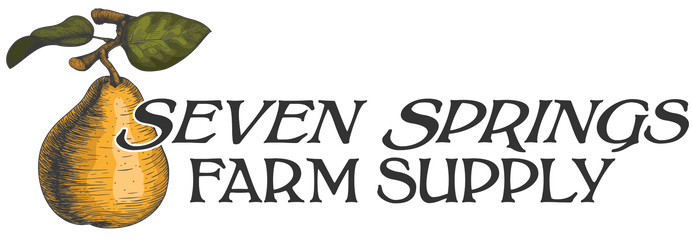
Greenhouse Container Sanitation 101
Each spring farmers start organizing, planning, and starting their seedlings for the new growing year. One essential part of having a successful season and crops is making sure your infrastructure, greenhouses, and seed starting materials are clean and sanitized to prevent the spread of diseases that can take root at the vulnerable beginning stages of crop production.
Reusing seed starting trays, flats, and other containers is a great way to save money and be more sustainable; however, those previously used items may be harboring unseen problems. Start your season off right by cleaning and sanitizing your materials to clear away potential pests, diseases, and other critters lying in wait.
The most important thing about reusing these materials is knowing the optimal procedures for ensuring your containers and trays are ready for use. The following guide provides a model two-step process that will give your crops a better chance, and it all starts with properly removing the organic matter clinging to your pots and flats.
Step One: Cleaning
Organic matter can be seen or unseen, plus some soil components, like fatty acids, help it adhere to the surface of containers resisting regular water rinses (even typical sanitizers are unable to break these bonds). So, the key is to use a properly charged cleaner that breaks down the fatty acids, puts them into a suspension, and allows for easy rinsing.
This means the age-old notion of pressure washing, basic water rinses, and soaking in buckets or barrels for a clean slate need to be revised. There is a better way. Also, pressure washing can be detrimental if you’re working indoors because it can provide a means for organic matter and the pathogens that harbor within it (we’ll get to that later) to spread throughout your facility. Additionally, a water wash will only remove visible organic matter; while an alkaline cleaner will break those bonds, ensuring even the unseen organic matter is thoroughly removed.
Cleaning before sanitation proves more effective than steam sterilization. In 2019, Iwasaki Brothers Greenhouse in Hillsboro, Oregon, USA, was looking for a method to control root diseases in propagation. Their goal was to eliminate Thielaviopsis basicola inoculum, a soil-borne fungus that causes black root rot, from their propagation trays. They focused on their sanitation program, set out new protocols, and found precleaning with an alkaline cleaner** was the ideal process for recycling their trays. See more info here - Plug Tray Sanitation


Remember, soil-borne disease and fungal pathogens can survive on used containers under the protection of organic matter. Without pre-cleaning, future crops may be susceptible to infection. While your containers may look clean after a quick rinse, they could harbor Thielaviopsis (black root rot), Phytophthora, Pythium, Fusarium, Rhizoctonia, or Sclerotinia. A proper cleaning step using an alkaline cleaner can save you a lot of time and money.
Step Two: Sanitation
When it comes to sanitizing, look for a no-rinse, minimal REI* product like SaniDate® 5.0 to save time and reduce water consumption. SaniDate 5.0 is a peroxyacetic acid-based sanitizer and disinfectant trusted by many large-scale operations throughout the country, not to mention it is manufactured
right here in the United States of America.
BioSafe Systems’ manufactured peroxyacetic acid (PAA) is a stabilized form of hydrogen peroxide (H2O2) and acetic acid formulated from the highest quality, food-safe ingredients. PAA's chemical formation differentiates it from lower quality, commercial hydrogen peroxide. SaniDate 5.0's active ingredients are subjected to rigorous quality control measures that produce clean chemistry with sustainable benefits over the generic peroxide formula. Most importantly, SaniDate 5.0 has a higher oxidation potential (ORP), making it ten times stronger than hydrogen peroxide alone.
With chlorine, there are discharge concerns and potential additional rinse steps on hard surface applications, not to mention the potential for dangerous off-gassing. Choosing SaniDate 5.0 for your facility ensures everyday operations go on without a hitch or headache. SaniDate 5.0’s 0-hour REI* and no rinse step speaks to worker safety and efficiency, whereas conventional sanitizers may not, allowing containers to be put back into production 10 minutes after application.
Implementing the Process
When it comes to implementing this two-step process, the setup is simple. Think about what you might see in a restaurant with a triple sink. You can do something similar with large tubs or troughs. One tub is for the cleaner, the next one is for rinsing, and the third one is for sanitizing. If you have a larger operation, you can accomplish the same system with vats.
In some instances, you can put cleaner in a hose-end sprayer and spray the pots, but a dunk solution ensures full coverage.
We hope that some of these tips and this simple two-step process will provide you insight on effective greenhouse container sanitation as well as ensure a clean and successful start to your growing year!
If you have any questions please feel free to reach out via email (eric@sevenspringfarmsupply.com) or give us a call at 1(800)540-9181
Follow BioSafe Systems on Instagram - @biosafe_systems
*1-hour REI when applied via fogging or spraying
** BioSafe Systems product, GreenClean Alkaline Cleaner, was utilized for this case study. Please note this product is not OMRI-Listed.

Leave a comment